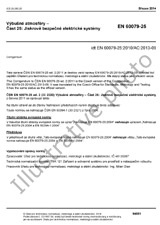We need your consent to use the individual data so that you can see information about your interests, among other things. Click "OK" to give your consent.

IEEE C62.31-2020
IEEE Standard for Test Methods and Preferred Values for Low-Voltage Gas Discharge Tube Surge-Protective Components
Translate name
STANDARD published on 26.1.2021
The information about the standard:
Designation standards: IEEE C62.31-2020
Publication date standards: 26.1.2021
SKU: NS-1016668
The number of pages: 32
Approximate weight : 96 g (0.21 lbs)
Country: International technical standard
Category: Technical standards IEEE
Annotation of standard text IEEE C62.31-2020 :
Revision Standard - Active.
This standard applies to low-voltage gas discharge tube (GDT) surge-protective components for application on systems with voltages less than or equal to 1000 V rms or 1500 V dc. These protective components are designed to limit voltage surges on balanced or unbalanced communication circuits and on power circuits operating from dc to 420 Hz. This standard contains a series of standard test criteria for determining the electrical characteristics and ratings of gas discharge tube surge-protective components.
ISBN: 978-1-5044-7082-7, 978-1-5044-7083-4
Number of Pages: 32
Product Code: STD24421, STDPD24421
Keywords: arc current, arc voltage, breakdown voltage, discharge current, follow current, gas discharge tube, GDT, glow to arc transition current, glow voltage, holdover voltage, IEEE C62.31, sparkover voltage
Category: Surge-Protective Devices
We recommend:
Updating of laws
Do you want to be sure about the validity of used regulations?
We offer you a solution so that you could use valid and updated legislative regulations.
Would you like to get more information? Look at this page.



 Cookies
Cookies
